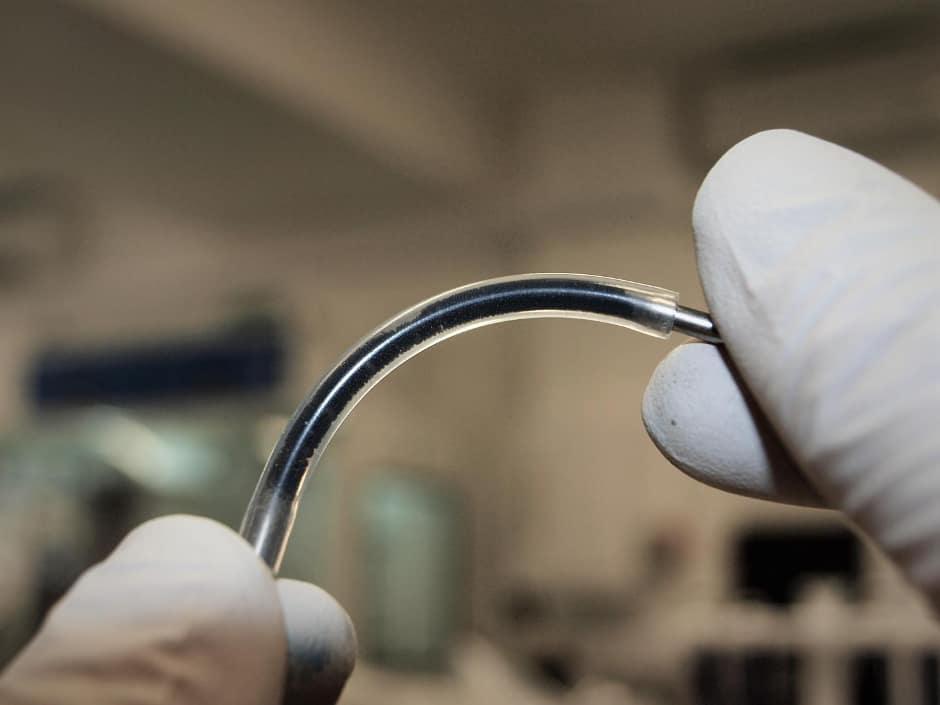A new liquid-based strain sensor developed at Sussex University promises to monitor respiratory conditions more accurately and affordably thanks to the use of graphene.

The unobtrusive strain sensors are claimed to be the most sensitive liquid-based devices ever developed and could be used to monitor sick babies in remote parts of the world, or keep track of new babies' heart and breathing rates with automatic updates sent to their parents’ smart phones. According to Sussex University, the new device could also be utilised by people with conditions such as sleep apnea.
Key to the device is a liquid made from an emulsion of graphene, water and oil, which conducts electricity.
The breakthrough, by Prof. Alan Dalton, from the School of Mathematics and Physical Sciences, and his team of physicists at Sussex University, is described in a paper published in Nanoscale. A prototype strain sensor has been created and the team are talking to commercial sponsors to fund further research that will bring the product to market.
The team were inspired to create this new health monitor after the Bill and Melinda Gates Foundation called for new affordable wearable health technologies for babies in situations where resources are scarce.
Graphene is a two-dimensional material made from carbon atoms that is strong, flexible and conductive. When a channel or tube holding the liquid is stretched, even by a small amount, the conductivity of the liquid changes, so respiration rates and pulses of people wearing the device can be tracked.
Because the new liquid technology is so sensitive, it picks up very small signals when attached to the body. Currently, a baby’s pulse is monitored with clunky sensors that are attached to the infant’s feet or hands, which often fall off. The information is then relayed to a monitor by wires which can restrict the child's movement.
The new development would see the monitoring done wirelessly and non-invasively with a 'fitness tracker'-like band - or even embedded within the fabric of a sensor vest for the baby to wear.
Prof. Dalton said: "Using the conducting liquid emulsions we have developed, we will produce cheap, wearable sensors based on graphene. The devices will be comfortable, non-invasive and can provide intuitive diagnostics of breathing and heart rate. We will eventually have a suit that the baby can wear which will read-out all vital information wirelessly. We hope to see this made available within two to four years.
"In the laboratory we have created a sensor that has the potential to drastically improve early detection of life-threatening symptoms such as sleep apnea or cardiac arrhythmia, where constant monitoring with conventional equipment is challenging outside of the hospital environment."
"Of course the ultimate potential is wider than that. Anyone interested in tracking their heart or respiration rates - joggers for example - may be interested to wear this technology within their exercise gear.”
Dr Matthew Large, lead researcher on the project in the School of Mathematics and Physical Sciences, added: "What we've done is similar to how you might make a salad dressing; by shaking together water and oil, you make tiny droplets of one liquid floating in the other because the two don't mix. Normally, the droplets would all collect together and the liquids separate over time. We've resolved this by putting graphene in. The graphene, which is an atom thick, sits at the surface of the droplets and stops them from coalescing.
"What's quite exciting about this new type of conductive liquid is how sensitive it is to being stretched. When the graphene particles are assembled around the liquid droplets electrons can hop from one particle to the next; this is why the whole liquid is conductive. When we stretch our sensors we squeeze and deform the droplets; this moves the graphene particles further apart and makes it much harder for the electrons to hop across the system. The sensitivity of this new kind of strain sensor is actually much higher than a lot of existing technologies, and it is the most sensitive liquid-based device ever reported by quite a significant margin."
According to Prof. Dalton, the strain sensor product could be rolled out on a big scale due to the affordability of graphene derived from naturally-occurring graphite.
“This is good news for health services because the new technology will not be expensive to make and buy,” he said. “It also means it should be affordable to individuals."




April 1886: the Brunkebergs tunnel
First ever example of a ground source heat pump?